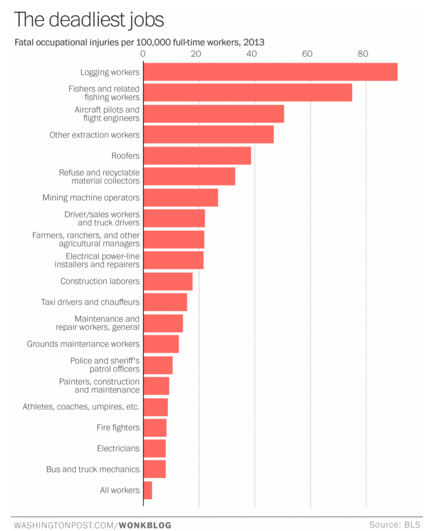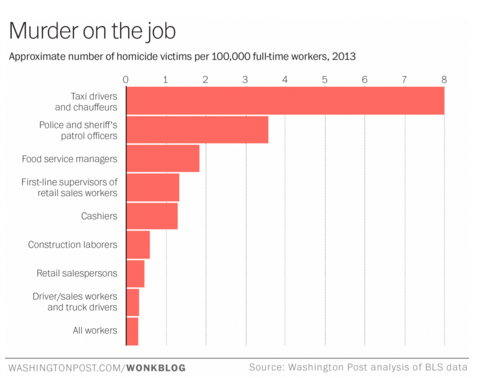The 6 Most Dangerous Jobs in the U.S.

By:
Most people don't choose their careers based on how likely they are to die at work. But it doesn't hurt to consider the odds before you apply. The Washington Post's Wonk Blog took a look at data from the Bureau of Labor Statistics and charted the body count in professions where Americans had the most fatal occupational injuries in 2013, and the results might not be what you expect.
 The Washington Post/Wonk Blog - washingtonpost.com
The Washington Post/Wonk Blog - washingtonpost.com
These six jobs are the most likely to kill you.
1. Logging
The logging industry accounted for a fatal work injury rate of 91.3 people out of every 100,000 in 2013, the highest rate in any field.
Though its death rate is startlingly high, the industry's particular hazards aren't surprising. Tree trunks and logs can move and fall unpredictably, crushing workers, CNN reported.
The rate spiked dramatically in 2012, surpassing that of fishing, which had previously held the number one spot, according to CNN. Rates of death by logging also more than doubled between 2009 and 2012.
Why? "A boom in new home construction may have forced the industry to hire more inexperienced workers who are more prone to accidents," Neil Ward, vice president of the Forest Resources Association, speculated to CNN.
Finding workers proves challenging, said Robert Smith, president of RL Smith Logging in Olympia, Wash. "It's really hard work, and a lot of people don't want to work that hard," he told CNN. "The pool you're picking from is very thin."
2. Fishing
People who fish for a living died at a rate of 75 per 100,000, the BLS reported.
Many of these deaths occurred when vessels went down, and most of those ships sank or capsized because of large waves, weather conditions, or hitting sand bars, according to a 2008 report by the National Institute for Occupational Safety and Health on the industry's occupational hazards, cited by Oregon Live.
Other deaths occurred when people fell overboard or were injured on deck — or diving off it, according to the NIOSH report.
Some industry experts attribute the workplace fatalities to ships falling into disrepair.
“Fishing vessels are uninspected, so the Coast Guard doesn’t have jurisdiction to go on and look at the condition of the vessel," Jennifer Lincoln, an Alaska-based NIOSH epidemiologist and leader of the agency’s Commercial Fishing Safety Research and Design Program, told the Center for Public Integrity in 2012. "There’s no standards that a fishing vessel has to be built to or maintained to. That’s much different than a ferry or cargo ship.”
3. Flying a plane
Pilots and flight engineers also suffered high fatality rates: 50.6 out of 100,000, the BLS reported.
Pilot deaths occurred on bush, charter, and air taxis, CNN reported. Major airlines had much lower pilot fatality rates.
Unlike fishing deaths, pilot deaths were mostly due to human error and not to aircraft trouble, CNN reported.
4. Extracting oil or gas
Oil and gas extraction is also a dangerous business: It had a 2013 fatal injury rate of 59 per 100,000, the BLS reported.
Several hazards and conditions caused fatalities in the industry, including vehicle accidents; explosions and fires; falls; getting struck by, caught in, or caught between machinery; confined spaces; and exposures to chemicals, the federal Occupational Safety and Health Administration reported.
5. Roofing
Roofing was the most fatal profession related to construction in 2013, with a fatal injury rate of 38.7 per 100,000. Falls from roofs also made up a third of all fatal construction falls between 1992 and 2009, according to a study by the Center for Construction Research and Training Data Center published in the Journal of Safety Research.
Far more people fell to their death from residential roofs than fell at commercial construction sites, the study reported. Small companies had high rates of fatal roof falls, and there were also high rates of fatalities among Hispanic workers.
The study's authors stressed the importance of enforcing OSHA regulations and fall protection procedures, particularly for small roofing and construction companies and for foreign-born workers.
6. Collecting recycling
The rate of death for the recycling industry was 33 per 100,000. Many of these fatalities involved workers being struck by passing vehicles, according to John Haudenshield, the National Waste and Recycling Association's director of safety.
The NWRA has supported “Slow Down to Get Around” legislation in some states, requiring drivers to slow when they approach a waste or recycling collection vehicle. But many motorists still feel the urge to speed around the vehicles, a 2014 NWRA survey found.
“Whether it is driver apathy or distracted driving, or other factors, the leading safety voices representing companies across our industry have been engaged in a multi-year effort to ensure we have the practical tools and resources available to all of our members that will help us reverse these trends," Haudenshield said in a statement.
Why some jobs kill
Overall, 40 percent of workplace deaths were attributable to transportation accidents, The Washington Post reported. About 13 percent were due to falls; 11 percent involved being struck by machinery or objects.
But 9 percent were attributable to homicide, which involved a very different set of professions than did accidental workplace deaths. The Post's Wonk Blog charted which fields ranked the highest in workplace homicide:
 Washington Post/Wonk Blog - washingtonpost.com
Washington Post/Wonk Blog - washingtonpost.com
Taxi drivers, police officers, restaurant managers, retail supervisors, and cashiers were among the workers most frequently killed on the job by another person. Some of these workers dealt with large amounts of cash and were more likely to die during an armed robbery than, say, those operating a commercial fishing boat, The Post pointed out.
Cab drivers had the highest homicide rate: They often drive alone late at night, making them easy targets for crime.
